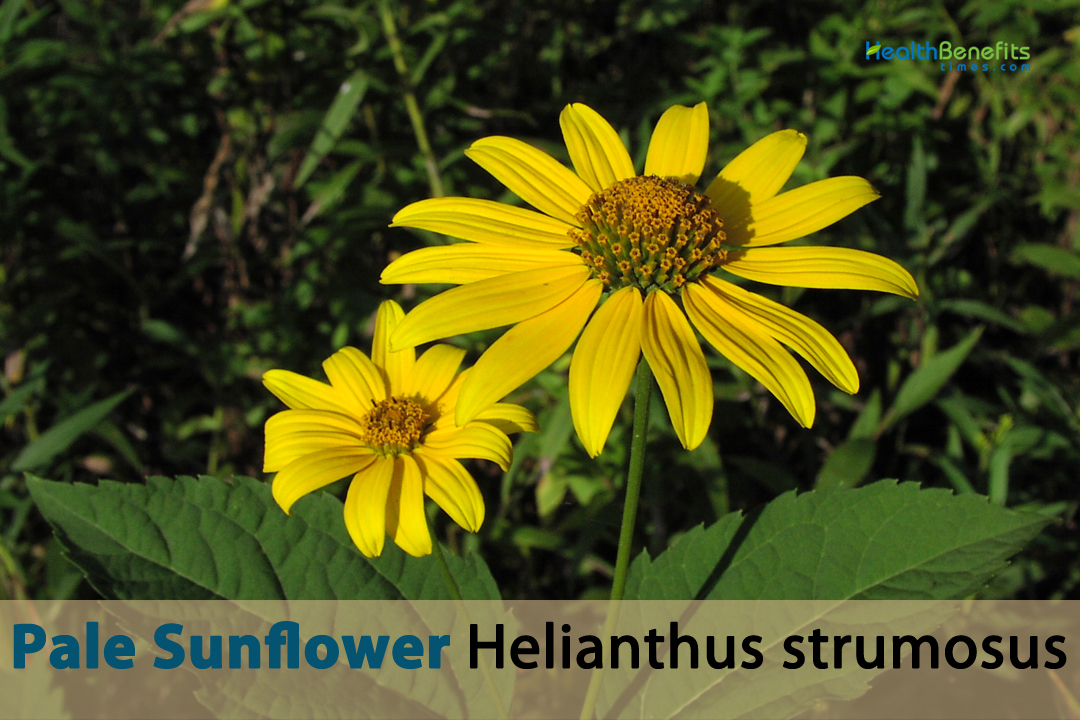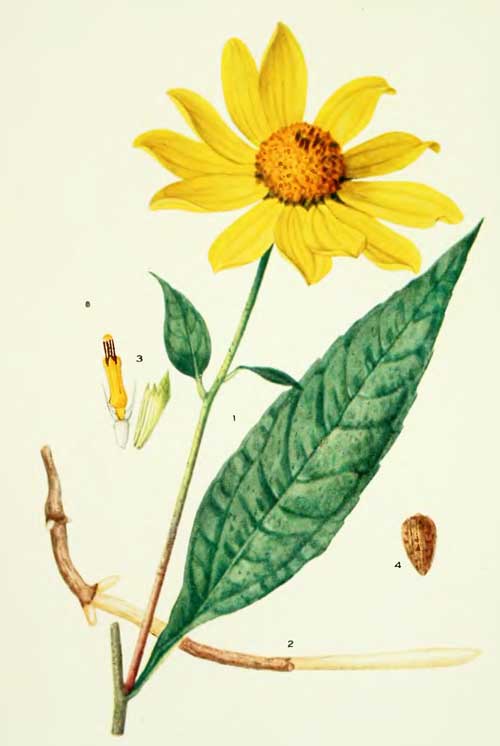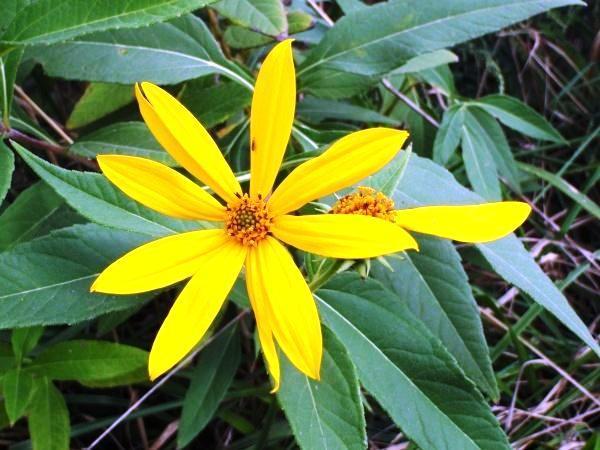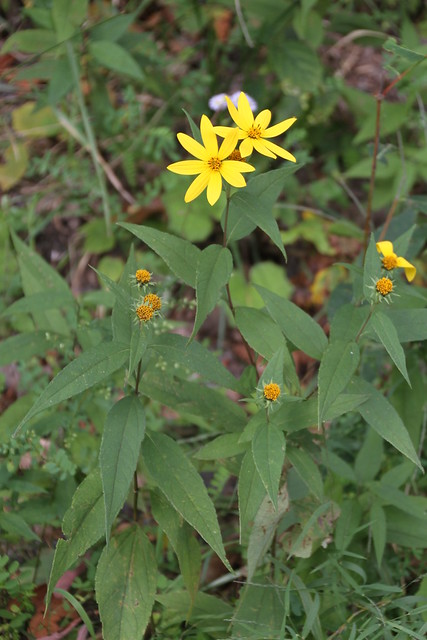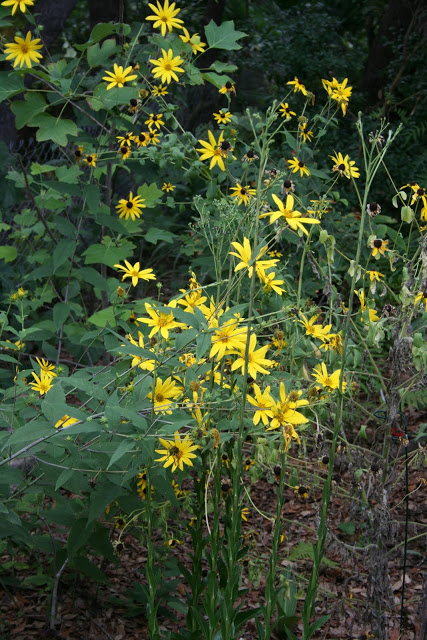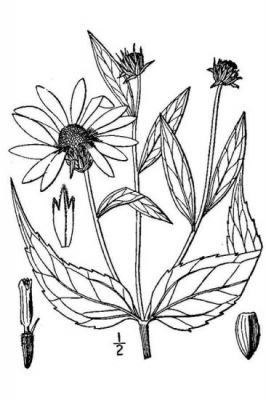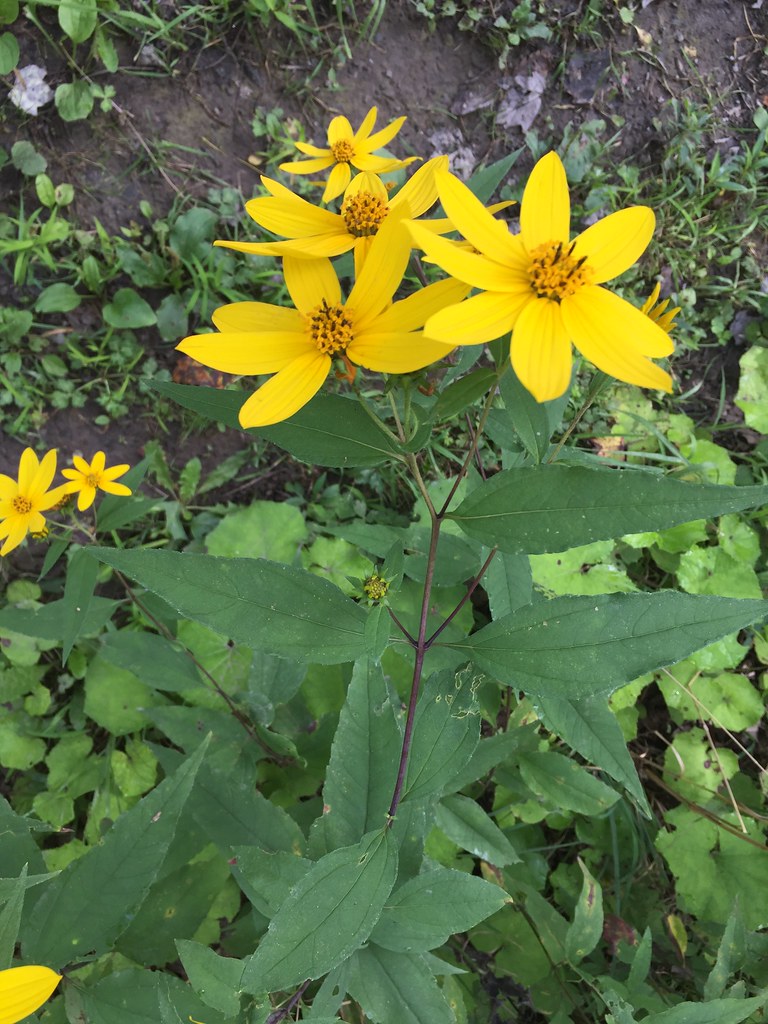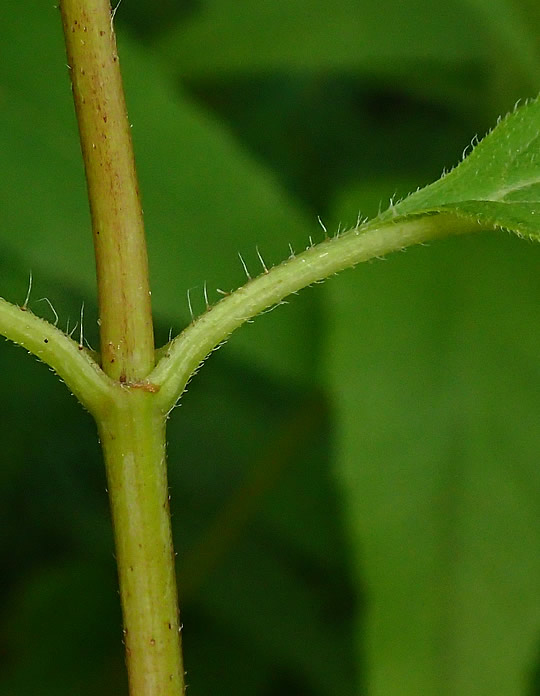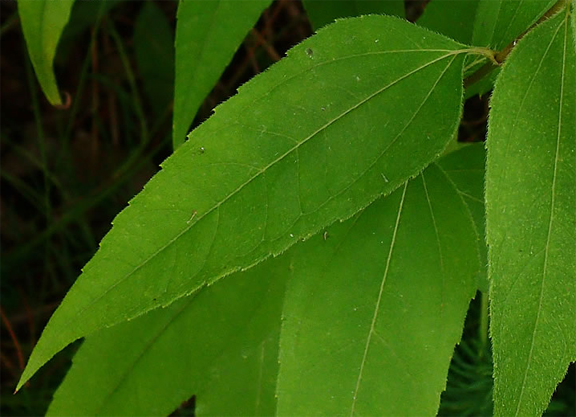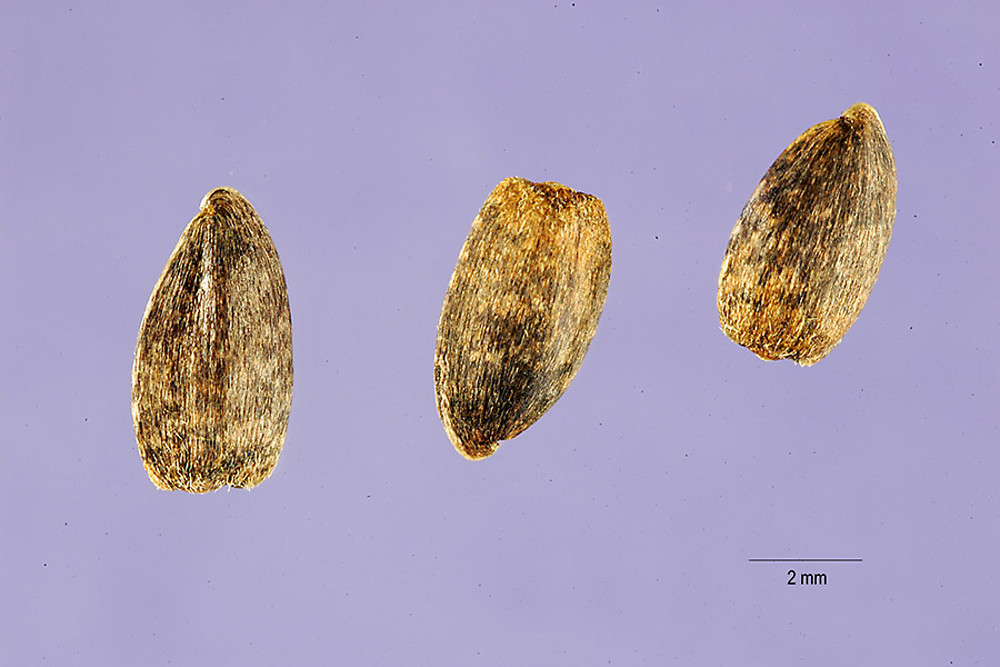| Pale Sunflower Quick Facts | |
|---|---|
| Name: | Pale Sunflower |
| Scientific Name: | Helianthus strumosus |
| Origin | North America, ranging from eastern Canada to parts of the United States |
| Shapes | Small, dry, one-seeded achenes that do not split open when mature |
| Major nutrients | • Protein • Healthy Fats • Dietary Fiber • Vitamins • Minerals • Antioxidants • Phytochemicals • Carbohydrates • Zinc • Iron • Potassium • Calcium • Manganese |
| Health benefits | Heart Health, Rich in Fiber, Bone Health, Skin Health, Brain Function, Blood Sugar Regulation, Weight Management, Cancer Prevention, Boosts Immune System, Supports Bone Density, Eye Health, Blood Pressure Regulation, Hair and Skin Health |
| Name | Pale Sunflower |
|---|---|
| Scientific Name | Helianthus strumosus |
| Native | North America, ranging from eastern Canada to parts of the United States |
| Common Names | Pale Sunflower, Woodland Sunflower, Pale leaf Woodland Sunflower, Woodland False Sunflower, Appalachian Sunflower, Rough Sunflower, Woodland Yellow Sunflower, Soft Sunflower, Heartleaf Sunflower, Fuzzy Sunflower, Little leaf Sunflower, Rough Woodland Sunflower, Soft leaf Sunflower, Woodland Prairie Sunflower, Pale leaf Sunflower, Heartleaf Woodland Sunflower, Hoary Sunflower, Soft leaf Prairie Sunflower, Hairy Sunflower, Downy Sunflower |
| Name in Other Languages | Afrikaans: Bleek Sonneblom Albanian: Lule Dielli Blegtore Amharic: Qänqirṣṣṭə yamayk’är (ቀኝቅርፀት የማይቀር), Ts’ḥaf Ts’ḥaf Albererim (ጸሐፍ ጸሐፍ አልበረሪም) Arabic: Abad Al-Shams Al-Shahba (عباد الشمس الشاحبة) Armenian: Shaganakats Arevmtahavat (Շագանակած Արևմտահավատ), Paragaylakats Arevmtahavat (Պարագայլակած Արևմտահավատ), Blek Arevelyany (Բլեկ Արևելյան) Assamese: Phekua Suryamukhi (ফেকুৱা সূৰ্যমুখী) Aymara: Pale Sunflower Azerbaijani: Solğun Günəçiçəyi, Ağ Sünbül, Solğun Günəbaxan Bashkir: Aq qanatın ayu (Аҡ ҡанатын аю) Basque: Haur Hezur-izen, Iruin Eguzkilorea Belarusian: Bledzyayuchy Sonechnik (Бледзяючы Сонечнік) Bengali: Mlāna Sūryamukhī (ম্লান সূর্যমুখী), Plābita Sūryamukhī (প্লাবিত সূর্যমুখী), Shwet Suryamukhi (শ্বেত সূর্যমুখী), Abīkṣita Sūryamukhī (অবীক্ষিত সূর্যমুখী), Phika Suryamukhi (ফিকা সূর্যমুখী) Bihari: Phīkā Sūryamukhī (फीका सूर्यमुखी) Bosnian: Blijedo Suncokret Breton: Bleuniadur an Heol Gwan Bulgarian: Bled slŭnchogled (Блед слънчоглед) Burmese: Aweikthang Myauksutu (အဝေးသင်း မြောက်သူသီး), Aam Pwek Thaar Mhing (အားမားပြက္သားမင်း) Catalan: Girasol Pàlid Cebuano: Balhibong Katilingban Cherokee: Digadisquu (ᏕᎦᏘᏯ), Gilvnage’i Ugedisdi (ᎩᎳᎾᎬᎢ ᎤᎦᎢᏍᏗ) Chichewa: Sunflower Wachikhulupili Chinese: Cāngbái xiàngrìkuí (苍白向日葵) Chuvash: Shurt ushkăs (Шурт ушкăс) Corsican: Girasole Pallidu Croatian: Blijeda Suncokret Czech: Bledý Slunečnice, Bledá Slunečnice, slunečnice naduřelá Danish: Bleg Solsikke, Bleg Solhverv Dari: Gol-Mohammadi Shapur (گلمحمدی شاپور) Divehi: Pale Sunflower Dutch: Bleke Zonnebloem, Engelsche zonnebloem, Zonnewortel Dzongkha: Pale Sunflower English: Pale-Leaf Sunflower, Paleleaf Woodland Sunflower, Rough Sunflower, Swollen Sunflower, Pale-Leaved Sunflower, Woodland Sunflower, Pale-Leaved Woodland Sunflower, Rough-Leaved Sunflower, Perennial sunflower Esperanto: Palida Sunfloro, Blida Sunfloro Estonian: Kahvatu Päevalill Faroese: Bleik Sólblóm Fijian: Pale Sunflower Filipino: Maputlang Araw-araw, Pale Sunflower, Bughaw Sunflower Finnish: Kalpea Auringonkukka, Vaalea Auringonkukka French: Tournesol Pâle, Hélianthe scrofuleux, Hélianthe strumosus, Hélianti, hélianthi, héliantis Frisian: Bleek Sinneblom Gaelic: Grianmar Pale Galician: Xirasol Pálido Georgian: Blidi mzisamisa (ბლიდი მზისამისა), Blek Mzishxedi (ბლეკ მზისხედი) German: Blasser Sonnenblume, Kropfige Sonnenblume, Topinambur ‘Völkenroder Spindel Greek: Chlomós Ílios (Χλωμός Ήλιος), Chloró iliótropio (Χλωρό ηλιοτρόπιο) Greenlandic: Puisiarnaq Sioraq Gujarati: Mūnjhāvaṇu Sūrajmukhī (મૂંઝાવણું સૂરજમુખી), Phīko Sūrajmukhī (ફીકો સૂરજમુખી) Haitian Creole: Tounen Solèy, Pèl Soulye Hausa: Fure Fure Mai Leme (فرے فرے مائی لیمے), Launin Taauri Hawaiian: Pua Laʻelaʻe, Pālupalu Pua Lā, Pua Lā Pālupalu Hebrew: Chamssin Chivvi Hindi: Phīkā Sūrajmukhī (फीका सूरजमुखी) Hmong: Kuv Koj Kib Huv Lub Koom Haum, Nkauj Nkauj Yeeb Yaj Hungarian: Halvány Napraforgó, Nagylevelű napraforgó Icelandic: Bleik Sólargeisli, Bleik Sólblóm Igbo: Ọsụsụ Ịzụdọlị Nwoke, Igbazụri Ọzụdọlị Nwoke Indonesian: Bunga Matahari Pucat Inuktitut: Pale Sunflower Irish: Plúr Ghrianach Léirscáil, Grianmar Pale Italian: Girasole Pallido, Elianto perenne Japanese: Pēru Sanfurawā (ペールサンフラワー), Inu kiku imo (イヌキクイモ) Javanese: Pale Sunflower Kannada: Bili Suryakanti (ಬಿಳಿ ಸೂರ್ಯಕಾಂತಿ) Kazakh: Assausha Kungiz örekshesi (Ассауша Күнгіз өрекшесі), Altau Apary (Алтау Апары), Aq mäńgilі (Ақ мәңгілі) Khmer: Trǒk krịk bɑŋkʼae (ត្រកក្រិកបង្កើត), Phluv Ka Preah Atit Somethi (ផ្លូវការព្រះអាទិត្យសុមេធិ) Kinyarwanda: Pale Sunflower Klingon: Pale Sunflower Korean: Changbaekhan haebalagi (창백한 해바라기) Kurdish: Gulê Sor, Gulperi Pîsk Kyrgyz: Sazanak üydünbökö (Сазанак үйдүнбөкө), Jolkuu sary kyzyl (Жолкуу сары кызыл), Pökür Salkın (Пөкүр Салкын) Lao: Pale Sunflower Latin: Pallidum Heliánthus Latvian: Bāls Saulespuķe Lithuanian: Blyškusis Saulėgrąžas, Grakš Luxembourgish: Blecht Sonnenblumm, Bleik Sonnenblum Macedonian: Bled Sonchogled (Блед Сончоглед) Malagasy: Pale Sunflower Malay: Bunga Matahari Pucat Malayalam: Vilakku Mukkulan (വിളക്ക് മുക്കുളം), Peḽ Sūryakānti (പേൽ സൂര്യകാന്തി), Peḽ Sūryamukhi (പേൽ സൂര്യമുഖി) Maori: Putiputi Rāhui Marathi: Phāḍaphaḍīta Sūryapushpa (फाडफडीत सूर्यपुष्प), Phāḍakē Sūryamukhī (फाडके सूर्यमुखी) Maltese: Girasol Xahar, Sunflower Pali, Girasol Pallidu Maori: Kōwhaiwhai Mahana Marathi: Phāḍakē Sūryamukhī (फाडके सूर्यमुखी) Mongolian: Gol Gatsuur (Гол Гацуур), Saaral günzgiin mökhön (Саарал гүнзгийн мөхөн), Tungalag NaranTseTseeg (Тунгалаг Наранцэцэг) Myanmar: Ashay Htwet Tawng Pint (အရှေ့သွေးတောင်ပင်) Navajo: Tłʼoh Bitsʼáánááná, Chʼil Bitsiilane, Dááłtsą́ą́ Níłtsą́ą́ Bee Hózhǫ́ǫ́gi Nepali: Pārī Sūryamukhī (पारी सूर्यमुखी), (Pyālo Sūryamukhī (प्यालो सूर्यमुखी), Ghopyaali Sūryamukhī (घोप्याली सूर्यमुखी), Phikā Sūryakamal (फिका सूर्यकमल) Norwegian: Blek Solsikke Nyanja: Pale Sunflower Odia: Phikā Sūryyamukhī (ଫିକା ସୂର୍ଯ୍ୟମୁଖୀ) Pashto: Zarghooni Zarghoona (زرغونۍ زرغون), Pekhē Khor Khor Shōshe (پېښې خور خور ښوښ) Persian: Aftâbgordan Parrang (آفتابگردان پررنگ) Polish: Blady Słonecznik, Blada Słonecznica, Slonecznik miekkowlosy Portuguese: Girassol Pálido Punjabi: Māṛī Sūrajmukhī (ਮਾੜੀ ਸੂਰਜਮੁਖੀ), Hathāṁ Vālā Sūrajmukhī (ਹੱਥਾਂ ਵਾਲਾ ਸੂਰਜਮੁਖੀ), Phikkā Sūrajmukhī (ਫਿੱਕਾ ਸੂਰਜਮੁੱਖੀ) Quechua: Pale Sunflower Romanian: Floarea-Soarelui Palidă Russian: Blednyy podsolnechnik (Бледный подсолнечник), podsolnechnik zhelozisto-vypuklyy (подсолнечник желёзисто-выпуклый) Samoan: Lātū Paumalū, Pale Sunflower Sanskrit: Śveta Sūryamukhī (श्वेत सूर्यमुखी) Scottish Gaelic: Flùr na Grèine Bàn, Grianmar Pale Serbian: Bledi Suncokret (Бледи Сунцокрет) Sesotho: Pale Sunflower Shona: Pale Sunflower Sindhi: Pīṭha Sindhi Kanba (پيٺ سنڌي ڪنب) Sinhala: Pola Sūrāmakanti (පොල් සූරාමකන්ති), Polova Sūryakannā (පොළොව සූර්යකන්නා) Slovak: Bledý Slnecnica, Bledý Slniečko, slnečnica žľaznatá Slovenian: Bledo Sončnico Somali: Guldhinshiye Furaay, Kaluunka Qorraxda Spanish: Girasol Pálido Sundanese: Pale Sunflower Swahili: Jua la Jua Nyepesi, Jua la Jua Palid, Pale Sunflower Swedish: Blek Solros, Strävsolros Tagalog: Halaman ng Pale Sunflower Tahitian: Tiare Māʻitiʻitiʻi, Pūrau ʻŌpūrū, Pale Sunflower Tamil: Palai Suriyakanti (பலை சூரியகாந்தி), Pali Sūriyakānti (பலி சூரியகாந்தி) Tajik: Gulkhandoni qorī (Гулхандони қорӣ), Polod Surkh (Полод Сурх) Tatar: Bik Yora (Бик Йора) Telugu: Pala San Phlavar (పల్ సన్ఫ్లవర్), Phīkā Sūryakānti (ఫీకా సూర్యకాంతి) Thai: Dok Tana-wan Si Siid (ดอกทานตะวันสีซีด), Thāntawan Sī Sī (ทานตะวันสีซี) Tibetan: རྨུང་གྲོང་དཀར་པོ། (Rmung grong dkar po), དུལ་བེད་རུ་མུ་རང་དྲུང་ (Dulbed Ru Mu Rang Drung) Tongan: Meʻakai Lāmoʻonia Tripuri: Pale Sunflower Turkish: Solgun Ayçiçeği, Solgun Güneşçiçeği, Solgyn Günbaşly Uighur: Kächey chüshekä uruqi (كەچەي چۈشكە ئۇرۇقى) Ukrainian: Blidy Soniashnyk (Блідий Соняшник) Urdu: Pila Sūrjmukhī (پیلا سورجمکھی) Uyghur: Pālə Chichirək (پالە چەچىرەك) Uzbek: Soyli Qishloq Quyonbogʻi, Soyli Quyonbogʻi, Pishanggoq Quyosh Valyrian: Pale Sunflower Vietnamese: Hoa Hướng Dương Nhạt, Cúc Phương Bạc Welsh: Blodyn yr Haul Llwyd, Blodyn Haul Pâl Xhosa: I-Phulela Phezulu, Iphephandaba Lomhlaba Yiddish: (Blas Zun-blime (בלאַס זון־בלימע), Bleyk Zun-blum (בלייק זון־בלום), Bloz Sonnenblo Yoruba: Osan Faweli Gbogbo, Irun Ọla, Pale Sunflower Zulu: Iqhwa Ekhahlelwa Likanye, Ibhulu Ekahlelwe Elulwimi, I-Phulela Phezulu |
| Plant Growth Habit | Deciduous rhizomatous perennial, herbaceous plant |
| Growing Climates | Woodland areas, prairies, meadows, forest edges, open woods, dry sandy ground, oak woods, along river banks, in fields, roadsides, clearings, sandy ridges, crests of limestone bluffs, prairie over chalk, rocky embankments, power line corridors and semi-cleared woodlands |
| Soil | Prefers well-draining, moist soils and can tolerate a range of soil types, including sandy, loamy, and clay soils. Partial shade to light dappled sunlight is ideal for its growth |
| Plant Size | About 2 to 6 feet (approximately 0.6 to 1.8 meters) and has a spread of around 1 to 3 feet (about 0.3 to 0.9 meters). |
| Root | Plant has both woody and rhizomatous roots, which are two different kinds of roots that do different things. |
| Stem | Slender and erect, growing upright from the base of the plant. They are typically covered with small, fine hairs that give the stem a rough texture. Stems are unbranched except in the flowers. |
| Bark | Plant lack traditional bark and stems are covered with a layer of epidermal tissue that serves to protect and support the plant |
| Leaf | Leaves are 2½ to 7 inches long, ¾ to 4 inches wide, rounded or slightly tapering at the base, usually with a long taper to a pointed tip but lower leaves may be more egg-shaped. Leaf stalks are 3/8 to 1¼ inches long, leaf edges are toothless or with irregular, shallow teeth, surfaces |
| Flowering season | From August through September |
| Flower | Bright yellow flowers of Helianthus strumosus resemble classic sunflower blooms, albeit on a smaller scale. Each flower has a central disc surrounded by ray florets. The flowers are generally 1 to 2 inches (2.5 to 5 cm) in diameter. |
| Fruit Shape & Size | Small, dry, one-seeded achenes that do not split open when mature |
| Seed | Seed about ¼ inch long and without a tuft of hair, but with 2 bristly scales at the tip |
| Varieties |
|
| Major Nutrition |
|
| Plant Parts Used | Leaves, roots, Stem |
| Propagation | By seed, Softwood Cuttings, Division |
| Lifespan | Around 3 to 5 years or more |
| Season | September |
| Available Forms |
|
| Health benefits |
|
Plant Description
Pale Sunflower is a grassy, deciduous, rhizomatous, perennial plant that grows between 2 and 6 feet (0.6 to 1.8 meters) tall and spreads between 1 and 3 feet (0.3 to 0.9 meters). The plant grows in wooded areas, prairies, meadows, open woods, forest edges, and dry sandy ground, along river banks, oak woods, in fields, clearings, roadsides, sandy ridges, and crests of limestone bluffs, rocky embankments, and prairie over chalk, power line corridors, and semi-cleared woodlands. The plant does best in soils that drain well and stay wet, but it can also grow in sandy, loamy, and clay soils. It grows best in places with some shade to a little bit of light sun.
Appropriate growing environment of Pale Sunflower
Pale Sunflower is a native North American wildflower that typically thrives in specific growing environments. Here’s information about its appropriate growing conditions:
- Habitat: Pale Sunflower grows in woods, open woods, fields, and the edges of forests. It likes habitats that get only some or dappled sunlight instead of full sun.
- Light: Pale Sunflower does best in part shade to light sunlight with a few bright spots. It grows best under the shade of trees or in places where the sun shines through the leaves.
- Soil: The plant likes dirt that drains well, stays moist, and is slightly acidic to neutral. It can grow in different kinds of dirt, like sandy, loamy, and clay.
- Moisture: Pale Sunflower likes to stay moist, but once it is established, it can also survive dry times. For healthy growth, especially in drier circumstances, there needs to be enough water.
- Temperature: It grows best in regions that are between warm and cool. Pale Sunflower is from North America and has adapted to the changes in temperature that come with the seasons there.
- Propagation: It is possible to grow this plant from seeds. Plant the seeds right where you want them to grow in the fall, because most seeds need a time of cold stratification before they can grow.
- Growth Habit: Pale Sunflower is a plant that lives for many years and grows from rhizomes. Over time, it can spread and form colonies.
- Companion Plants: When planting in gardens, choose companion plants that do well in partial shade or wooded areas, like native ferns, wildflowers, and other species that like the shade.
- Wildlife Attraction: Pollinators like bees and butterflies are attracted to Pale Sunflower, which helps keep the local environment healthy.
- Elevation: Depending on where it lives, it can be found at different heights, from the plains to higher elevations.
- Natural Woodland Gardens: Pale Sunflower grows well in native plant gardens, along the edges of woods, and in naturalistic landscapes because its growth patterns are similar to those of its original habitats.
Root
Pale Sunflower has both woody and rhizomatous roots, which are two different kinds of roots that do different things. Fibrous roots are thin structures that look like threads and spread across the dirt. They start at the plant’s base and spread out, making a thick network. These roots are very important because they hold the plant firmly in the ground and protect it from wind and other natural forces. Rhizomes are horizontal underground roots that grow below the surface of the soil. These rhizomes can grow new shoots, leaves, and roots, which lets the plant grow new plants and spread over a large area.
Fine root hairs grow from the woody roots, making it much easier for the plant to take in water and nutrients. The roots use the earth around them to get water and important nutrients like nitrogen, phosphorus, and potassium. These nutrients are important for the growth and health of the plant as a whole.
Stem
The roots are thin and straight and grow up from the plant’s base. They usually have small, fine hairs all over them, which make the stems feel rough. From a single rhizome, many stems can grow, making colonies of plants that are all linked to each other. The stems give the plant its shape and hold the leaves and flowers up so they can get as much sunshine as possible for photosynthesis. The leaves, flowers, and other parts of the plant get water and nutrients from the ground through the stems. Fine hairs on the stem could protect it from animals or help it keep water.
Bark
Pale Sunflower is an herbaceous plant that doesn’t have bark on its roots like woody plants do. Instead, its roots are usually covered with a layer of epidermal tissue that protects and supports the plant, protects the plant’s inner tissues, controls water loss through transpiration, and interacts with the environment.
Leaves
The leaves are in the shape of a lance, which means they are long and thin and end in a point. They are set up in pairs on different sides of the stem. Each pair of leaves comes out of the stem at the same level but on the opposite side. Most of the time, the ends of the leaves are serrated, which means they have small, tooth-like projections. The texture of a leaf’s surface can change, but it is often rough or has a hairy feel. Fine hairs on the surface of the leaf may serve more than one purpose, such as guarding the plant from herbivores, keeping water in, and preventing water loss.
The leaves are usually green because they have chlorophyll, which is the pigment that makes photosynthesis happen. Changes in leaf color could be caused by the weather, age, or the presence of other pigments. Photosynthesis happens mostly in the plant’s leaves. This is where the plant turns sunshine, carbon dioxide, and water into energy-rich carbs. Leaves give insects and other animals a place to live and food to eat. Some butterfly species’ larvae need plants to eat, and the leaves can be those plants. This helps pollinator populations.
Flowers
The flowers look like daisies because they have a center disc and ray florets around it. Each flower head is made up of a clump of disc florets in the middle and many ray florets around the disc. The ray blooms are bright yellow, which is what gives the flowers their sunny look. The center disc blooms are often darker than the yellow rays, which makes for a nice contrast. Most flowers bloom from the end of summer to the beginning of fall. When flowers bloom can change based on the weather, the soil, and other factors in the area.
Flowers are very important to a plant’s ability to make more plants because they draw pollinators. Pollinators use the ray flowers as “landing platforms” so they have a place to rest while they get nectar and pollen. Bees, butterflies, and other animals, like flies, come to the flowers to pollinate them. The flowers are pretty to look at because they are bright and happy. They look good in natural settings and parks. They add to the visual appeal of wooded areas and other places where the plant grows.
Fruits (Seed)
The names of the fruits are achenes. It’s a small, dry fruit with only one seed that doesn’t split open when it’s ready. After the flower has been pollinated and fertilized, the fertilized ovary grows into an achene. The wall of the ovary in the flower gets thicker and harder, protecting the seed. The achenes are released from the flower head’s center disc as the flower head matures. The achenes can be moved to new areas by wind, animals, or other ways, which helps the plant reproduce and spread.
History
Before Europeans came to North America, the people who lived there already knew a lot about the plants and how to use them. Pale Sunflowers would have been around them because they grew in woods, fields, and along the edges of forests. Native people most likely dealt with this species of sunflower by gathering its seeds and using them as food and medicine.
As more Europeans moved to North America, they had more contact with local plants like Pale Sunflower. Even though most of the settlers’ attention was on foods brought from Europe, plants like sunflowers were still important to their lives. They would have watched how these plants interacted with animals in the area.
In the 1800s, people became more interested in local plants and how they could be used as decorations. People started to notice how pretty native wildflowers like Pale Sunflower were and saw that they could be used for gardening and restoring the environment. But it’s important to remember that growing and crossing wildflowers wasn’t as common as it is now.
Efforts to save native plants and restore ecosystems got more attention in the 20th century. Even though Pale Sunflower might not have been bred into different types of cultivated plants, having it in native plant parks and conservation projects would have helped people see and learn more about it.
Native plants are becoming more popular again because they are good for the environment and look nice. Pale Sunflower is still known for how it helps pollinators, how beautiful it is, and how it fits into local ecosystems.
Varieties of Pale Sunflower
Pale Sunflower is a perennial plant that belongs to the sunflower family (Asteraceae). It is often found in woodlands, along forest edges, and in meadows. While not extensively cultivated like some other sunflower species, it has several interesting varieties based on natural variations in its growth habits, foliage, and flower characteristics. Here are some notable varieties of Pale Sunflower
- Helianthus strumosus var. strumosus: This is what a normal Pale leaf Woodland Sunflower looks like. It has thin stems, leaves in the shape of a heart, and bright yellow flowers with light yellow centers. The flowers bloom in late summer or early fall and bring insects to the plant.
- Helianthus strumosus var. corymbosus: This type is known for its corymb-like inflorescence, which is a clump of flowers at the top of the stem. The flowers look like the usual kind. They have bright yellow petals and a pale yellow center.
- Helianthus strumosus var. maximiliani: Some people think of this variety, Helianthus maximiliani, as a different species. People often call it the “Maximilian Sunflower.” This tall version can grow up to 10 feet tall and has many bright yellow flowers that grow in branches along the stem. It is often grown in parks because it looks nice and gives color late in the season.
- Helianthus strumosus var. mollis: This type of sunflower, which is also called “Downy Pale leaf Woodland Sunflower,” has hairy or downy leaves and stems. The flowers look like the usual type, but what makes it stand out is the soft, velvety texture of the leaves.
- Helianthus strumosus var. odoratus: This type of sunflower is known for its smelly leaves, which is unusual for sunflowers. When you crush the leaves, they give off a nice smell. The flowers look like the normal kind because they have bright yellow petals and a white center.
- Helianthus strumosus var. villosus: This type stands out because its stems and leaves are very hairy or “villous.” The flowers look like the average kind, with yellow petals and white centers.
- Helianthus strumosus var. lineatus: This type stands out because its leaves are striped or lined, which is not like most varieties. Linear patterns are often very clear on the leaves.
Health benefits of Pale Sunflower
Pale Sunflower is a type of sunflower with pale or light-colored petals. While there might not be significant differences in health benefits between the pale sunflower and other types of sunflowers, sunflower seeds, oil, and other products derived from sunflowers do offer several health benefits. Here are some of the potential health benefits of consuming sunflower products:
1. Nutrient-Rich
Sunflower seeds are full of important nutrients like vitamins B and E, minerals like magnesium, selenium, and copper, and antioxidants. These nutrients are very important to your health and well-being as a whole.
2. Heart Health
Sunflower seeds are a good source of healthy fats, like monounsaturated and polyunsaturated fats. These fats can help lower bad cholesterol, lower the chance of heart disease, and improve the health of the heart and blood vessels.
3. Anti-Inflammatory Properties
Sunflower seeds have anti-inflammatory qualities because they have antioxidants in them, like vitamin E and selenium. Inflammation is linked to many chronic diseases, and eating these antioxidants can help lower it in the body.
4. Rich in Fiber
Sunflower seeds are a good source of fiber, which helps keep your digestive system healthy and keeps you from getting constipated. Fiber also makes you feel full, which helps you control your weight.
5. Bone Health
Minerals like magnesium and copper are found in sunflower seeds. These minerals are important for keeping bones healthy and stopping diseases like osteoporosis.
6. Skin Health
Sunflower seeds have vitamin E, which is good for your skin. Vitamin E is an antioxidant that helps keep skin cells from getting damaged by free radicals and UV rays. This makes skin look healthy and young.
7. Brain Function
Sunflower seeds are full of vitamin E and other antioxidants that are good for the brain and help it work well. Vitamin E in particular has been linked to a lower chance of memory loss as you get older.
8. Blood Sugar Regulation
Sunflower seeds have a low glycemic index and are a good source of protein and healthy fats. This makes them a good choice for keeping blood sugar levels normal.
9. Nervous System Support
Magnesium, which is found in sunflower seeds, is important for nerve activity. Getting enough magnesium may help avoid problems with the nervous system and help muscles relax.
10. Weight Management
Sunflower seeds have good fats, protein, and fiber, all of which can help control hunger and make you feel full, which may help you control your weight.
11. Cancer Prevention
Some of the chemicals in sunflower seeds, like phytosterols and vitamins have been looked at to see if they could lower the risk of certain types of cancer, like breast and colon cancer.
12. Digestive Health
Sunflower seeds have a lot of dietary fibre, which helps keep your digestive system healthy by keeping you from getting constipated and helping you have normal bowel movements. Getting enough fibre also helps keep your gut healthy and may help you avoid GI problems.
13. Boosts Immune System
Sunflower seeds have a lot of good things for you, like vitamin E, which helps your defense system. Vitamin E makes the body better at fighting off infections and helps keep the immune system in good shape.
14. Anti-Anxiety Benefits
Magnesium is a mineral that is found in sunflower seeds. It is known to help reduce stress and nervousness. Getting enough magnesium may help improve your mood and make you feel less anxious.
15. Supports Bone Density
Minerals like phosphorus and magnesium, which are found in sunflower seeds, are important for keeping bones strong. Bone problems like osteoporosis can be avoided by drinking it regularly.
16. Eye Health
Sunflower seeds have antioxidants in them, like vitamin E and selenium, which help keep your eyes healthy. These vitamins help protect the eyes from macular degeneration and cataracts, both of which are caused by getting older.
17. Hormone Balance
Essential fatty acids are found in sunflower seeds. These acids help make and control hormones. These fatty acids are especially good for the health of a woman’s hormones.
18. Blood Pressure Regulation
Sunflower seeds are a good source of the chemical potassium, which helps keep blood pressure at a healthy level. A diet high in potassium can help keep blood pressure at a safe level.
19. Hair and Skin Health
Biotin and copper are two nutrients found in sunflower seeds that help keep hair and skin healthy. Particularly, biotin is known to help hair grow and keep face healthy.
Culinary uses of Pale Sunflower
Pale Sunflower is not commonly known for its culinary uses like some other sunflower species, there are limited traditional and historical uses for certain parts of the plant. Here are some potential culinary uses based on general knowledge of wild plants:
- Young Leaves and Shoots: When cooked right, the young, soft leaves and shoots of Pale Sunflower could be eaten. They could be cooked like other leafy greens and be eaten as a veggie. Before eating any wild plant, though, you need to be sure you know what it is and get information from a reputable source.
- Flower Petals in Salads: Like many other edible flowers, the petals could be used to decorate salads and other foods. They might add a little color and a light, flowery taste. But make sure the flowers are properly labeled and that they were grown in a clean place.
- Tea Infusion: A mild plant tea could be made by putting dried or fresh leaves in hot water. The taste might be light and rich. Before you try this, make sure the leaves are safe to eat and that you are sure you know what kind of plant it is.
- Fritters or Pancakes: Young leaves can be finely chopped or ground and added to pancake or fritter batter. Like how herbs are used, the leaves could give these meals a different taste and feel.
- Infused Vinegar: You can make plant vinegar by putting leaves or flower petals in vinegar. The infused vinegar that you get can be used in sauces, marinades, or to boost the flavor of other foods.
- Stuffed Edible Leaves: Use the bigger, tenderer Pale Sunflower leaves to wrap things up. Before you steam or bake them, fill them with a combination of cooked grains, vegetables, herbs, and seasonings.
- Herbal Butter or Oil: Blend finely chopped leaves into softened butter or oil to make a tasty compound butter or infused oil. These can be added to food to make it taste better.
- Wild Herb Pesto: Make a wild herb pesto with leaves and other wild plants that you can eat, like wild garlic, dandelion greens, and more. You can spread this pesto on bread, put it on pasta, or use it as a dip.
- Herbal Salt or Seasoning: To make an herbal salt or seasoning blend, you need to dry and carefully grind leaves. Use it to give roasted veggies, grilled meats, or scrambled eggs a unique flavor.
- Herbal Wraps: Use large leaves to wrap things that you want to steam or grill. This can give the food you’re wrapping a light green taste.
Different uses of Pale Sunflower
Pale Sunflower is primarily appreciated for its ornamental value and its role in supporting pollinators in native ecosystems. Here are different uses of Helianthus strumosus:
- Ornamental Plant: Pale Sunflower is often grown as an ornamental plant in native plant gardens, woodland areas, and other naturalistic settings. Its bright yellow flowers add beauty to these areas and draw pollinators like bees and butterflies.
- Pollinator Support: Pollinators like bees and butterflies need food, and the nectar-filled flowers of Pale Sunflower are a good source. It can help local pollinator populations by being planted in parks.
- Native Habitat Restoration: Pale Sunflower can help bring back native plant communities and increase biodiversity in natural places when it is used in habitat restoration projects. It can help restore order to ecosystems by being there.
- Wildlife Habitat: Pale Sunflower can be a home for many kinds of animals, such as insects and small mammals. It gives shelter and could be a source of food, which makes the environment healthier.
- Educational Purposes: Pale Sunflower can be used to teach people about native plants, how pollination works, and how important it is to keep local ecosystems in good shape.
- Ethno botanical Research: When you look into how Pale Sunflower has been used by native people and in traditional ways, you can learn about cultural practices and how people have used the plant in the past.
- Seed Production: By letting Pale Sunflowers go to seed, you can help seed banks and conservation efforts and make sure that natural plant species will be around for future generations.
- Natural Landscaping: Pale Sunflower can improve the look and ecological worth of naturalistic landscapes or wildflower meadows where it is planted.
- Soil Stabilization: Due to its large root system, Pale Sunflower can help stop soil runoff. If you plant it in places where the soil is likely to wash away, it can help stabilize the soil and stop the loss of important topsoil.
- Shade and Windbreak: Pale Sunflower can be placed in a yard or landscape in a way that gives shade to smaller plants or acts as a natural windbreak to protect more delicate species.
- Companion Planting: Intercropping Pale Sunflower with other plants can help by bringing in good bugs, keeping away bad bugs, and making microclimates that are good for some crops.
- Craft and Artistic Uses: Pale Sunflower’s dried stems, leaves, and flower heads can be used to make things like flower arrangements, wreaths, and other natural displays.
- Public Landscaping: Planting Pale Sunflower in public parks, nature reserves, and other public places can make them look better, bring in more people, and help the environment.
- Natural Dye Source: Even though it’s not well known, some wild plants can be used to make natural dyes. Pale Sunflower might be interesting to look into as a possible color material.
Side effects of Pale Sunflower
There is limited information available regarding specific side effects of Pale Sunflower on human health. Here are some general considerations:
- Allergic Reactions: Some people might be allergic to or sensitive to Pale Sunflower and other plants. If you have had plant allergies in the past, it is best to do a patch test before putting any plant material on your skin or eating it.
- Toxic Look-Alikes: Before eating any wild plant, make sure you know exactly what it is. If you mistakenly ate a poisonous plant that looks like Pale Sunflower, it could hurt your health.
- Toxic Parts: Even though Pale Sunflower isn’t usually considered dangerous, some parts of plants can have chemicals that can be slightly irritating or make you feel bad if you eat them.
- Soil Contaminants: If Pale Sunflower grows in a place where the soil is dirty, it could take in harmful chemicals from the surroundings. This could make it dangerous to eat any part of the plant.
- Medicinal Interactions: If Pale Sunflower is used for traditional or medical reasons, it could interact with some medicines or worsen health problems that you already have. Before using any plant as medicine, you should talk to a doctor or nurse.
- Pregnancy and Breastfeeding: People who are pregnant or nursing should be careful about eating any wild plants. Before adding new veggies to their diet, it’s best to talk to a health care provider.
- Digestive Sensitivity: Adding new plant foods to your diet can sometimes make your stomach hurt, especially if your body isn’t used to them.
- Rare Individual Reactions: Even though it is rare, some people might have strange responses to harmless plants. If you spot any bad effects after taking it, stop using it and, if necessary, talk to a doctor.
References:
https://www.itis.gov/servlet/SingleRpt/SingleRpt?search_topic=TSN&search_value=36690#null
https://npgsweb.ars-grin.gov/gringlobal/taxon/taxonomydetail?id=27943
https://pfaf.org/User/Plant.aspx?LatinName=Helianthus+strumosus
https://gd.eppo.int/taxon/HELST
https://en.wikipedia.org/wiki/Helianthus_strumosus
https://www.minnesotawildflowers.info/flower/woodland-sunflower
https://plants.usda.gov/home/plantProfile?symbol=HEST


